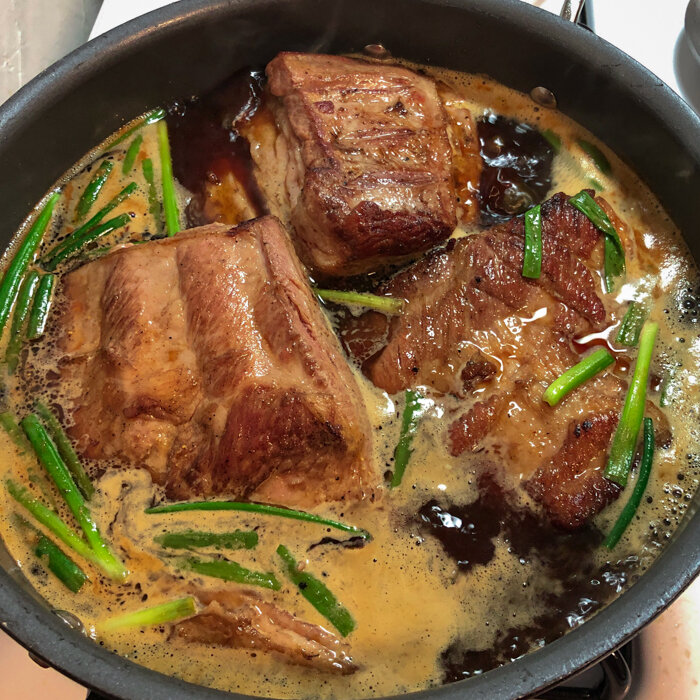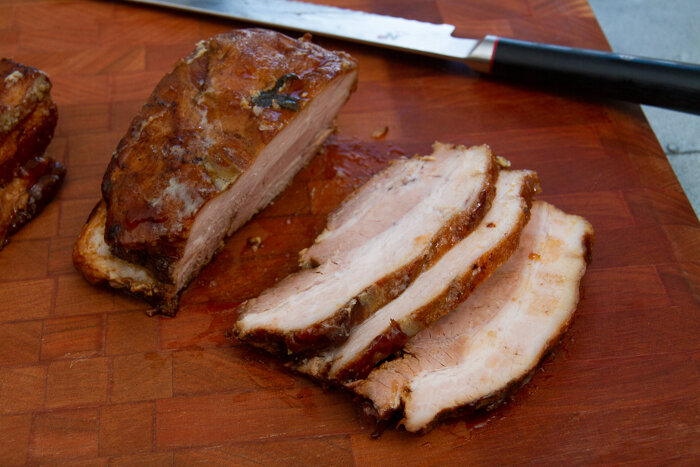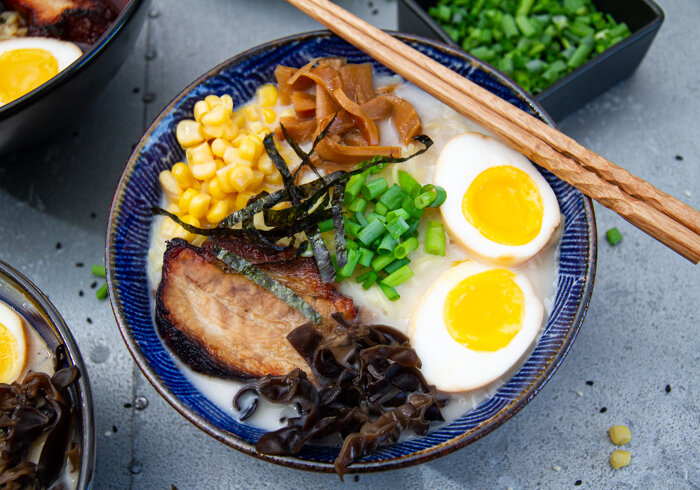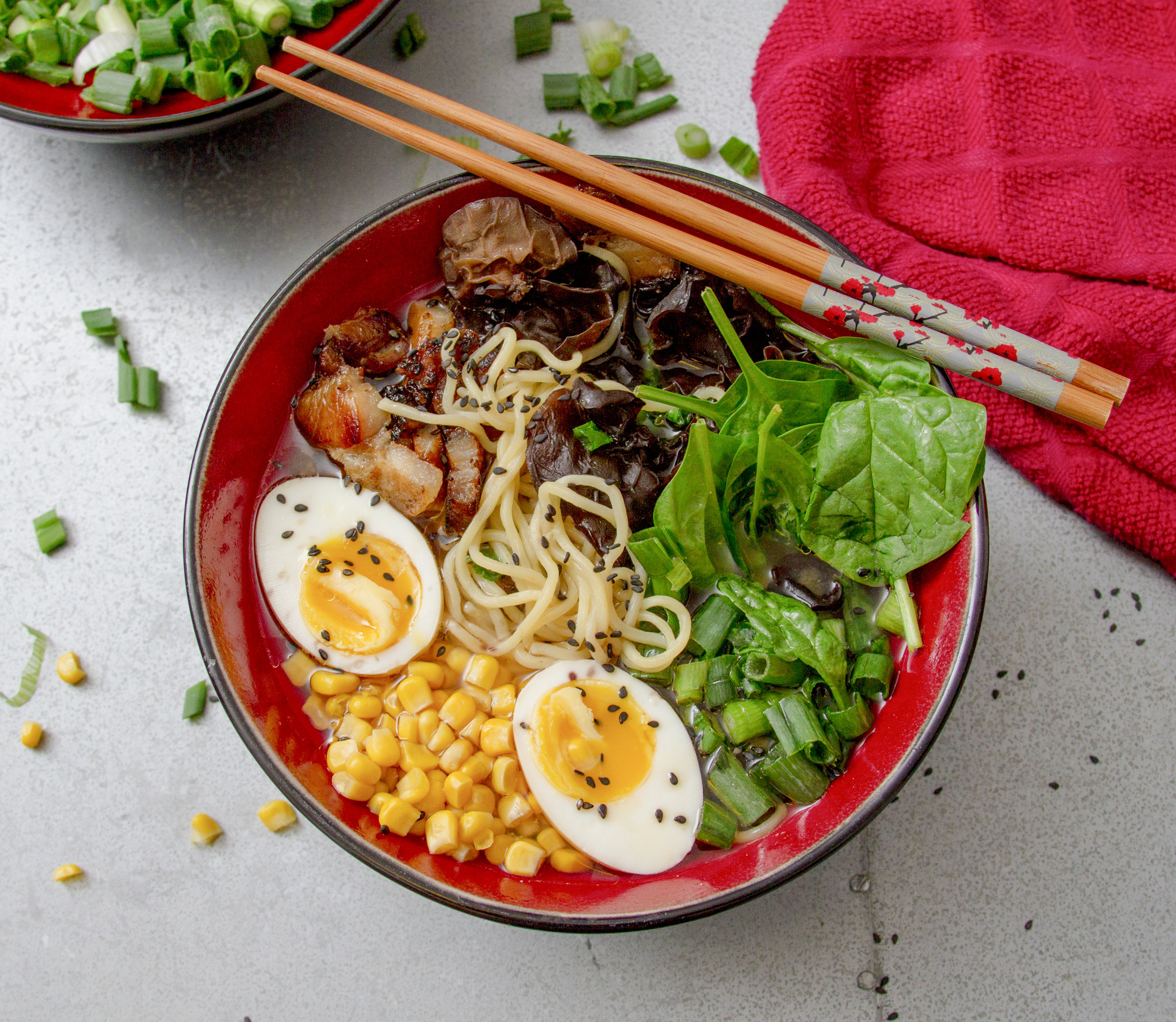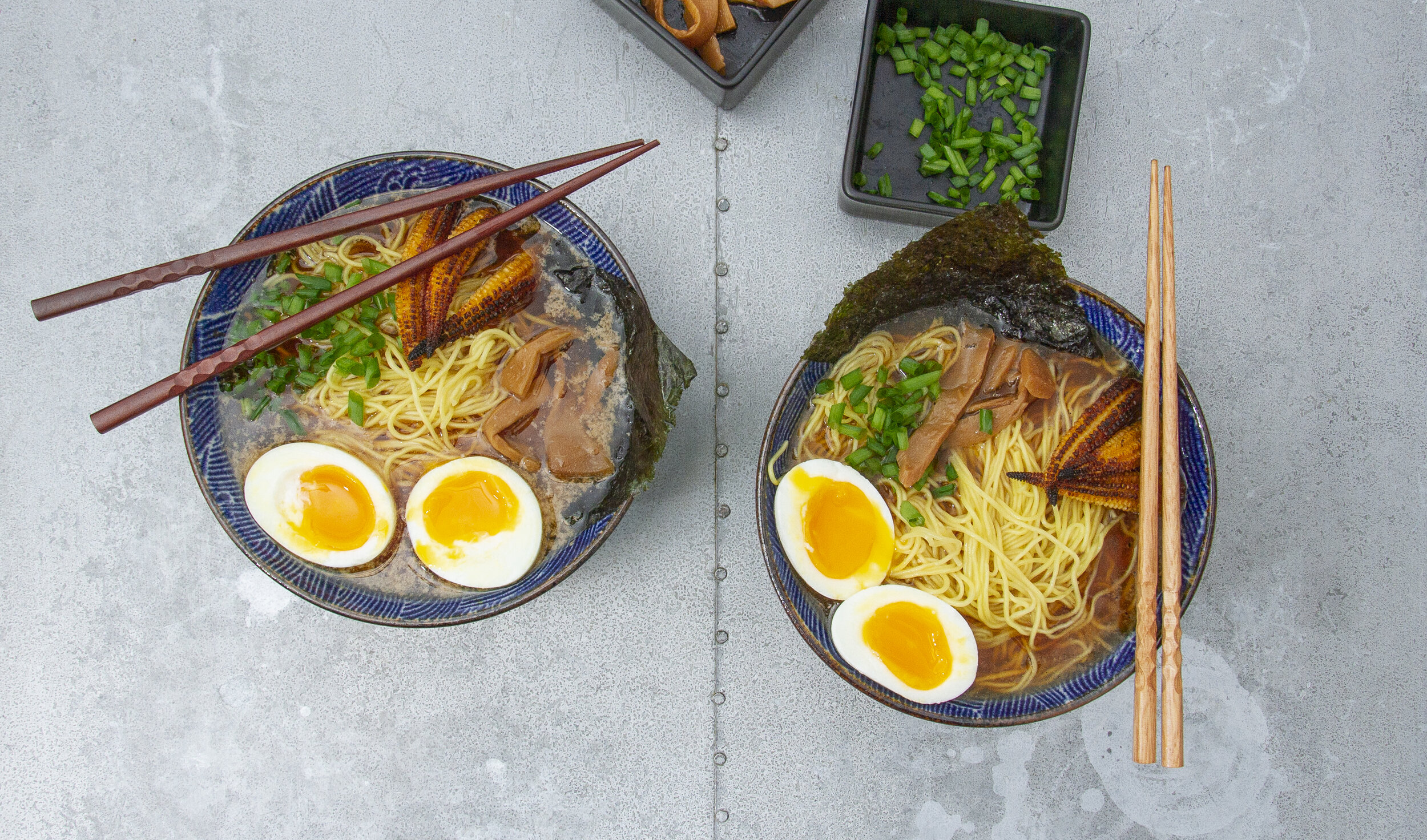Chashu Pork Recipe

As we are all staying at home, Jenna and I have been exploring new ways to get our ramen fix. So, we decided to make our very own chashu pork to go with some Myojo ramen kits we are trying out, and we are SUPER pumped with how it turned out!!!
I’ll start first with what chashu pork is. It’s a Japanese braised pork belly that get’s its name from its similarities to the Chinese char siu barbecued pork. Chashu is distinctly different though because it’s braised not barbecued. Braising it creates a melt in your mouth texture making it a perfect addition to a bowl of ramen! Oh and the slow cook just packs it with a delectable umami flavor.
Uncharted Meats
I have to admit that, while I love meats, of pretty much all kinds, it’s not something we cook very often, and I certainly had never cooked pork belly before. That is unless you count bacon, which I still frequently mess up. Anyway, the idea of braising pork belly was a little intimidating. I’ve only braised something once before, and while it was fine, it didn’t exactly turn out how I had hoped… I’m so happy we decided to give chashu a whirl though, because it’s actually very easy!
I had no idea where to begin cooking chashu, so naturally I turned to google for help. After checking out some of the recipes I decided that I liked this recipe from Serious Eats, and this recipe from Just One Cookbook. Ultimately, I based my recipe more off of Just One Cookbook; she goes into such thorough detail about each step that it really helped me feel confident about taking it on.
After a quick inventory check, I hastily decided (more on this later) that we had all the ingredients we needed except the pork. Here in New York, we have tiny grocery stores and we already knew that our regular store wasn’t going to have pork belly, so, we headed to our local butcher to pick some up. Before they wrapped it up, I had the butcher remove the skin. Some recipes call to keep the skin; the methodology being that it helps lock the moisture in as you cook it. However, having had chashu both with and without I already knew I preferred it without skin. Once I got home and unwrapped it, I realized that the slab of pork belly came with a bunch of ribs attached! Next time I’ll ask for them to remove the ribs as well… The first step is to either roll or sear the meat, neither of which are possible with ribs attached. So, I did my best to remove the ribs, but ultimately I ended up butchering it (Ba Dum Ching!). I accidentally cut too deep and ended up with two smaller slabs of pork belly - so rolling was out of the question. I might try actually rolling it next time, but it turned out so well I’m not sure it’s worth the effort!
Sizzle Time
All of the recipes I read called for a neutral cooking oil. This seemed totally unnecessary to me though since pork belly has a very high fat content. So, I decided to trust my gut with this one. I got out our cast iron skillet (any frying pan should be fine), heated it up and then put the pork belly fat side down. Within a minute the fat started to render and voilà there was plenty of oil! It was very similar to cooking a big batch of bacon. I then proceeded to sear the pork belly on all sides until it had a nice golden color and started to get a crust.
While it was searing, I prepped the other ingredients. I roughly chopped green onion, and went to peel and chop a knob of ginger. This is when I realized that we didn’t have any ginger! It’s an ingredient that we use frequently and we almost always have fresh ginger lying around. At this point it was too late to run out and get fresh ginger; luckily we have a large bottle of powdered ginger, so I decided to use that and hoped for the best. In hind sight, I wish I had measured the ginger, but instead I eyeballed what I thought was about the equivalent to a 1” knob of fresh ginger, and it turned out great! Now as people in a tiny apartment without a dishwasher, our cardinal cooking rule is to use as few dishes and utensils as possible. So, I proceeded to combine the rest of the ingredients directly into the pot I was going to cook with. Now, every other recipe I’ve read for chashu says to use a large deep pot; but I decided to use a large and about 3” deep sauté pan with a lid instead because it’s easier to clean than our big pot… Anyway the moral of the story is that any pot or pan with a lid that is deep enough to fit the pork and liquid and still have an inch leftover should be fine.
Get your Braise on
I added all the ingredients to the pot, brought it to a boil, and then added my seared pork belly to the pot. Now most of the recipes online call for a drop lid or (Otoshibuta as it’s called in Japan) which is a lid that fits inside the pot and helps to keep the ingredients submerged in the liquid, and prevent evaporation. Apparently you can buy these, but I don’t have one. Just One Cookbook has simple instructions on how to make an Otoshibuta out of tin foil. So that’s what I did. I’m not sure tin foil is actually heavy enough to keep stuff submerged, but I used it anyway. I also realized that my shortcut for an easier clean, might make the liquid evaporate faster since my pot is shorter; so, I decided to use both the Otoshibuta and the pot lid just to make sure all the liquid didn’t evaporate. I don’t know if that’s necessary, but it worked for me.
Once you add the pork, you reduce it to a simmer put the lid(s) on and then leave it to braise for the next 2 hours, flipping the pork every 30 minutes. To test if it’s done take a steak knife and jab it into the the thickest part. When it’s ready the knife should slide fairly easily all the way through.
Hurry Up And Wait
Once the pork is cooked, is when the hard part starts. You wanna let it cool enough to handle and then let it rest in the refrigerator until it’s completely cool. I let it rest overnight. But let’s be serious, you aren’t going to fill your home with the most delicious aromas of braised pork and soy sauce for hours on end without trying it..! Naturally, we tried some to make sure it turned out alright and it was SOO good. It was the perfect melt in your mouth texture; we could have eaten all of it right then, but we fought the urge and saved it for the ramen. (Quick Tip: Slice a little piece off before you sear the pork, so that you can try it once it’s cooked without having to slice the main piece before it’s properly rested)
So, once it cooled I transferred the pork to a container. I strained the liquid with a fine mesh sieve, and then poured ALL the liquid (most people only use a little, but in this case it felt like more was more) into the container with the pork to let it marinate overnight.
Eat It Already!
Now be prepared, pork belly is probably not the healthiest meat, let alone food, because it has a very high fat content. Super attractive I know, but that’s also why it tastes so good! After it’s cooled and rested, there will be a congealed layer of fat that’s made its way to the surface. When you open the container take a spoon and scoop out the surface fat. At this point, you wanna drain off the liquid into another container for use later. We used ours to make Ajitsuke Tamago (marinated soft boiled eggs, that are also a staple ramen topping).
Place the pork slabs on a cutting board and carve thin slices. I cut mine around a 1/4” thick. You now have a few options to heat it up: You can throw the slices into a pan with some of braising liquid, you can heat it up by placing it directly into a hot bowl of ramen, or you can make Aburi chashu, which is what we did. Aburi translates to “flame seared,” so aburi chashu means that you are heating it up with a flame. If you’ve been to a ramen joint like Mr. Taka then you may have seen them using a torch to heat their pork. That’s aburi chashu! We don’t have a butane cooking torch ourselves, if you do then you know what to do already! More likely though, you’re like us and don’t; we just used our broiler. Now I ran into the same problem that I have with bacon, and I almost overcooked it! So, keep a watchful eye on it! Once that’s got a little extra sear on it, take it out, plop it into your bowl of ramen, and enjoy some serious melt in your mouth porky goodness!!
Chashu Pork Recipe
Melt In Your Mouth Chashu Pork Is Easier Than You Think, And It’ll Take Your Ramen At Home To The Next Level! |
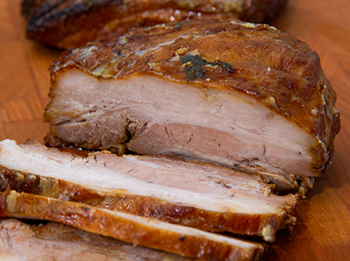 |
Prep Time: 10 Mins | Cook Time: 2 Hrs, 20 Mins
Total Time: 2 Hrs, 30 Mins (plus cooling time)
Ingredients:
- 3 lbs pork belly
- 3 - 4 scallions roughly chopped
- 1” knob of fresh ginger roughly chopped (or 1 1/2 Tsp of powdered ginger)
- 1 cup sake
- 1 cup soy sauce
- 2/3 cup sugar
- 2 cups water
Directions:
Cut Pork belly into 2 square-ish slabs. Put slabs fat side down in hot cast iron skillet (or frying pan). Sear on all sides until golden brown and a crust starts to develop.
- While the pork is searing combine remaining ingredients in large pot and bring to boil to make braising liquid.
- Once Pork is seared, add it to boiling braising liquid. Reduce to simmer, and cover with Otoshibuta (see above) and lid.
- Simmer for 2 hours flipping pork every 30 minutes. When a steak knife easily goes through thickest part it’s done.
- Let cool enough to handle.
- Remove pork from braising liquid and place into container.
- Strain braising liquid with fine mesh sieve.
- Pour all of the strained braising liquid into the container with the pork. Refrigerate until cold or preferably overnight.
- Remove congealed fat from surface of liquid.
- Remove pork from container and drain liquid, saving for later use. (You can use it to make Ajitsuke tamago, or even use it in a fried rice!)
- Carve pork into 1/4” slices.
- Reheat Pork using one of the methods below:
- Aburi Chashu - Place pork under boiler for approx. 7 minutes. until it’s sizzling and starting to char. (Alternately, use a butane cooking torch)
- Place pork and small amount of braising liquid into pan and re-heat over medium high heat.
- Place pork into hot bowl of ramen.
- Place in bowl of your favorite ramen and enjoy!!
grew up as a nomad, and currently calls New York home. When he's not slurping noodles he's editing stuff for TV. He's a quarter Japanese and has been using chopsticks since he can remember. His go to ramen order: Spicy shoyu with wavy noodles.


